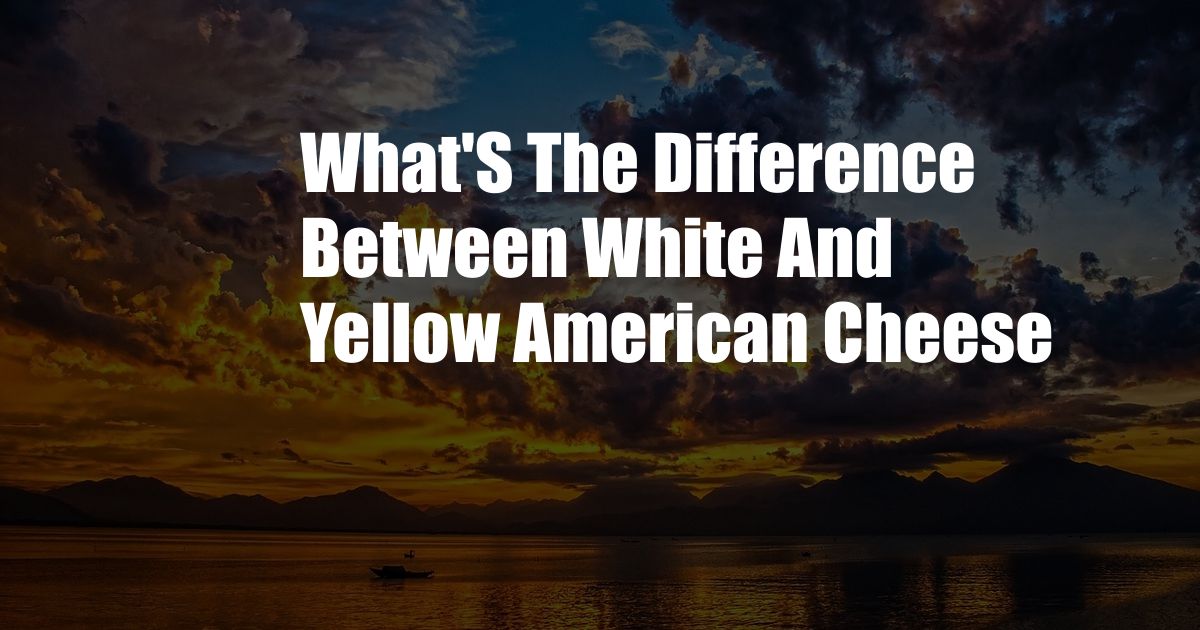
The Cheesy Dilemma: Unraveling the Differences Between White and Yellow American Cheese
In the melting pot of culinary delights, American cheese stands out as a beloved ingredient, gracing burgers, sandwiches, and mac and cheese with its gooey goodness. But beneath its unified banner, a subtle yet intriguing duality exists—white American cheese and yellow American cheese. While both share a similar composition, their contrasting hues and flavors set them apart as distinct entities in the cheese realm.
So, what exactly differentiates these two American cheese cousins? Let’s dive into their dairy-licious depths to uncover the secrets behind their contrasting identities.
Color Conundrum: The Whys and Wherefores
The most striking difference between white and yellow American cheese lies in their appearance. White American cheese, as the name suggests, is devoid of any yellowish tinge, presenting a pristine ivory hue. Yellow American cheese, on the other hand, proudly dons a golden-yellow color that adds a vibrant touch to any dish.
This color discrepancy stems from the addition of annatto extract, a natural food coloring derived from the seeds of the achiote tree. During production, annatto extract is blended into the yellow American cheese, imparting its distinctive yellow hue. White American cheese, on the other hand, remains untouched by this colorful ingredient, resulting in its pure white appearance.
Flavor Profile: Subtle Nuances
While their colors may differ dramatically, the flavor profiles of white and yellow American cheese exhibit only subtle variations. Both cheeses share a characteristic mild, buttery flavor that seamlessly complements various culinary endeavors. However, some discerning palates may detect a slightly tangier note in white American cheese compared to its yellow counterpart.
This slight tanginess is attributable to the absence of annatto extract in white American cheese. Annatto extract, aside from its coloring properties, also imparts a touch of sweetness to the cheese. Therefore, the lack of annatto in white American cheese results in a slightly tangier flavor.
Historical Evolution: A Tale of Two Centuries
The origins of American cheese can be traced back to the early 19th century, when dairy farmers in the United States sought ways to preserve their milk surplus. Through a process of heating, pressing, and aging, they inadvertently created a new cheese that was both shelf-stable and palatable.
Initially, all American cheese was white in color, as annatto extract was not yet widely used in the dairy industry. However, in the late 19th century, the introduction of annatto extract allowed cheesemakers to create yellow American cheese, which quickly gained popularity due to its eye-catching appearance.
Modern Applications: Versatility Unbound
Today, both white and yellow American cheese remain indispensable ingredients in countless culinary creations. Their unparalleled meltability makes them ideal for grilled cheese sandwiches, quesadillas, and ooey-gooey mac and cheese. White American cheese is often preferred for its tangier flavor, while yellow American cheese lends its vibrant hue to dishes that demand visual appeal.
Beyond their traditional applications, white and yellow American cheese have also found their way into innovative culinary ventures. Chefs and home cooks alike are experimenting with these versatile cheeses in everything from pizza crusts to gourmet sauces, proving that the cheesy possibilities are truly endless.
Tips and Expert Advice for Cheese Aficionados
Whether you’re a seasoned cheese enthusiast or just starting to explore the cheesy world, here are a few tips to enhance your American cheese experience:
- Go for quality: Opt for American cheese from reputable brands known for their commitment to quality and flavor.
- Store it right: Keep your American cheese wrapped tightly in the refrigerator to maintain its freshness and prevent it from drying out.
- Experiment with varieties: Don’t limit yourself to just one type of American cheese. Try different brands and varieties to discover the nuances of flavor and texture.
- Melt with finesse: For optimal melting, use low heat and stir the cheese occasionally to prevent clumping.
By following these simple tips, you can elevate your cheese-loving adventures and savor the delectable delights of white and yellow American cheese in all their glory.
Frequently Asked Questions: Unraveling the Cheese Mysteries
Q: Which type of American cheese is healthier?
There is no significant difference in nutritional value between white and yellow American cheese.
Q: Can I use white and yellow American cheese interchangeably in recipes?
Yes, white and yellow American cheese can be used interchangeably in most recipes. However, the tangier flavor of white American cheese may be preferable in certain dishes.
Q: Is white American cheese naturally white?
No, white American cheese is naturally yellow but is bleached to achieve its ivory hue.
Q: Which type of American cheese is more popular?
Yellow American cheese is more popular and widely available than white American cheese.
Q: Can I make American cheese at home?
While it is possible to make American cheese at home, the process is complex and requires specialized equipment.
Conclusion
The world of American cheese, despite its seemingly simple exterior, holds a wealth of intriguing differences between white and yellow varieties. From their contrasting colors to their subtle flavor variations, these cheeses offer a diverse palette for culinary adventures. Whether you prefer the tangy allure of white American cheese or the vibrant charm of yellow American cheese, one thing is certain—these cheeses will continue to grace our culinary creations with their unparalleled meltability and cheesy goodness.
Do you crave more cheesy insights? Share your questions and comments below, and let’s delve deeper into the fascinating world of American cheese together.